NextGen Supply Chain at DHL
Here’s how one of the world’s largest 3PLs is looking to tomorrow’s innovative technologies, including heads-up display and robotics, to transform its operations today.
If Modex 2018, the biannual materials handling trade event in Atlanta, is anything like years past, some of the best-attended booths will be from companies exhibiting technologies that will power distribution centers in the next generation supply chain. Those will be the booths with the latest in robotic mobile and piece picking solutions, virtual reality and heads-up displays such as Google Glass.
And, if this April’s show is anything like the last Modex, most of the visitors to those booths will be tire kickers who want to see the latest shiny objects, but probably aren’t planning on implementing them soon in their facilities. After all, solutions like three-level pick mezzanines delivering totes to a put wall or traditional pack station are still the dominant design in the DCs we see at Modern.
Still, some brave souls will be taking a hard look at tomorrow’s technologies today, running pilots to see where and how they might be applied in their operations; what kind of benefit they might deliver; and how they compare in cost to conventional solutions, including conventional automation.
One of those companies is DHL, the global third-party logistics (3PL) provider. Now, traditionally, 3PLs operate with conventional  processes, relying on people enabled by warehouse management systems (WMS) and data collection technologies. “Our challenge is that the bar has been raised on service level expectations,” says Adrian Kumar, vice president of solutions design for DHL Supply Chain. “Now that orders are shipped in a day or two, you can’t smooth out peak by picking the volume over five days. So, how do you deal with those orders within a day or two in a way that’s efficient and flexible?”
processes, relying on people enabled by warehouse management systems (WMS) and data collection technologies. “Our challenge is that the bar has been raised on service level expectations,” says Adrian Kumar, vice president of solutions design for DHL Supply Chain. “Now that orders are shipped in a day or two, you can’t smooth out peak by picking the volume over five days. So, how do you deal with those orders within a day or two in a way that’s efficient and flexible?”
Over the years, DHL has installed conveyors and shuttle systems in a small percentage of facilities operated for customers making long-term commitments. However, those kinds of investments aren’t practical with customers on short-term contracts or who are uncertain of how their volume is going to grow. The question is: Are there technologies somewhere in between traditional automation and manual processes?
“That’s why we’re looking at these emerging technologies,” says Kumar. “They are more flexible, they have a lower cost of entry than traditional automation, and they can scale with volume.” In some instances, he adds, DHL may be able to lease technologies like mobile robots and move them between distribution centers, like leasing a lift truck. “There’s absolutely a place for traditional automation, but it’s not for everyone, especially if a company doesn’t know where its business is going in the next few years,” he says.
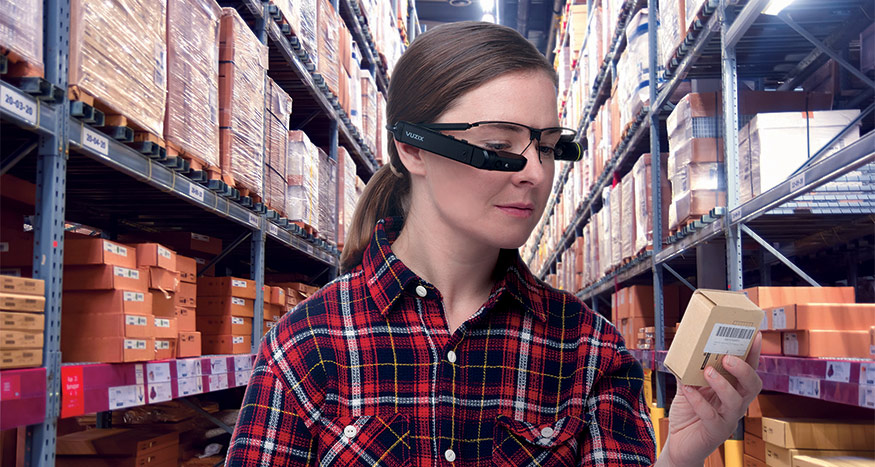
Vision technology is being used in collaboration with voice in pick to cart applications.
DHL is willing to make investments in next generation technologies because of its ability to leverage them across its network. “We are large enough to sponsor an innovation center and staff it with people who can conduct research and write papers on topics like sensors, drones and other technologies that help us decide where we might want to place our bets,” Kumar says. “We want to be ahead of the curve and get the best out of the workforce.”
Here’s a look at some of the initiatives DHL has piloted, along with a report on a robotics implementation in one of its facilities in Memphis (see below)
A vision for vision
Google Glass, which Google introduced in 2013 to bring computing power to eye wear, may have been a flop with consumers, but today, heads-up displays are finding a warmer reception in business and industrial settings. DHL partnered with middleware provider Ubimax and hardware provider Vuzix on a cart-based vision picking pilot, which was originally sponsored by DHL’s innovation center.
The idea, says Kumar, was to use the glasses as the pick assist device in a multi-modal solution, rather than paper or RF scanning to drive the process. “In a conventional pick-to-cart solution, an operator is picking an item, allocating it across up to 12 totes on the cart and then moving to the next item to be picked,” Kumar says. “If you’re using paper or an RF scanning device, that’s a lot of information to communicate to the operator. You can install lights on the carts, but that’s capital intensive.”
In the DHL process, an order selector scans a bar code label on a cart, and then scans the 12 totes to get things going. At that point, the WMS sends the order information for that cart to the middleware. It, in turn, creates the pick strategy and communicates the first location on the display. When the picker arrives at the pick location, he or she sees an augmented image of the quantity of items to pick and in which tote they should be placed on the cart. The picker confirms the pick and asks for the next assignment through voice-activated controls on the glasses.
“The display shows a schematic of the cart,” Kumar explains. “There are three levels and four slots per level on the cart, and all the slots are color coded. The number of items needed for a slot are displayed on that location. It’s very ergonomic.”
DHL realized a 10% productivity improvement during a pilot in an omni-channel facility in Ohio that distributes women’s fashions and decided to roll it out. “A lot of automation creates a major disruption when you put it in,” Kumar says. “In this case, we’d been using RF scanning, and we could use the same carts as before. It was a matter of switching off the RF guns for Google glasses, and we didn’t have to change our layout. Anytime you can put a new technology into existing operations, that’s a bonus.”
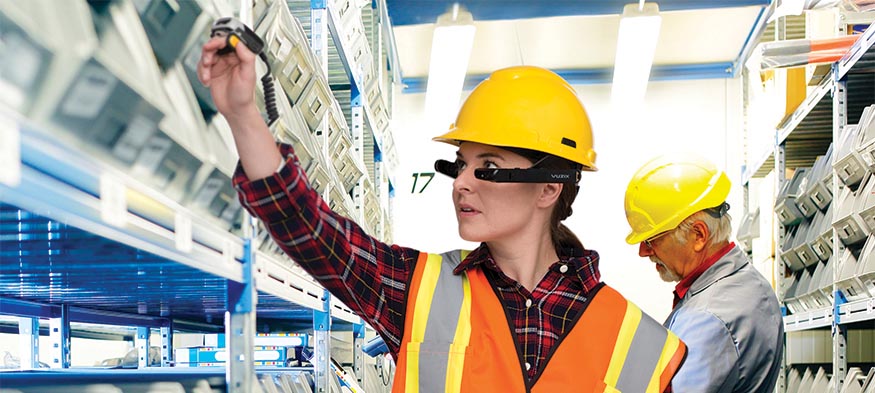
Going mobile
Few technologies have captured the imaginations of materials handling professionals and the public like robots. Analysts like IDC’s John Santagate note a 100% increase in venture capital funding in the space between 2015 and 2016, rising from $922 million to $1.95 billion in that year. Moreover, Santagate is predicting a five-year compound annual growth rate of 21% for robotics, with the industrial market, which includes materials handling robots, taking the lion’s share.
Count DHL among those companies that is watching the evolution of the market. Kumar’s interest is in mobile solutions from companies like Effidence, 6 River Systems and Locus Robotics. “These new solutions are flexible, scalable and more cost competitive,” says Kumar, adding that, like heads-up displays, they can also work collaboratively with associates in an existing infrastructure.
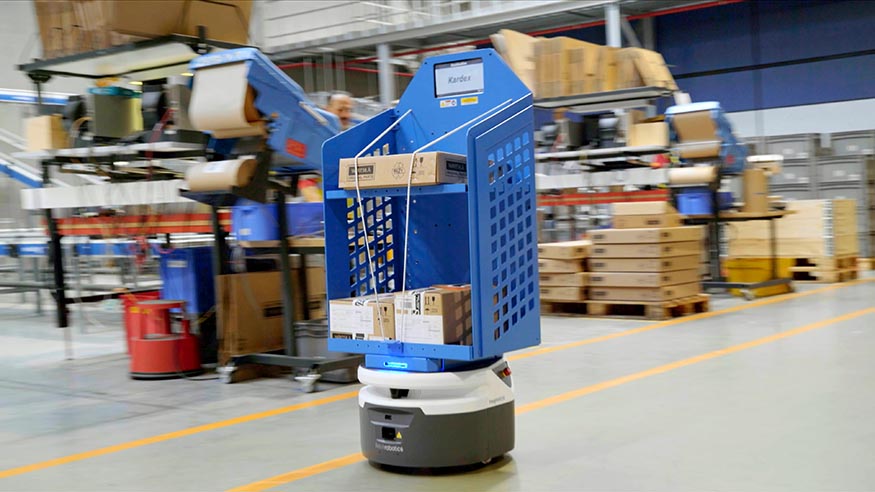
Robots like the one pictured above represent one of several mobile collaborative robotic strategies deployed in DHL DC’s.
DHL is using several strategies at various facilities.
- Follow me: Developed with Effidence, the follow me strategy, also referred to by DHL as collaborative automated order picking, involves an automated cart, almost resembling a child’s wagon, with slots on the top for cartons. The robotic cart can also act as a tugger, pulling other carts behind it. In this approach, the robotic cart is not integrated with a WMS. Instead, it follows a picker who controls the robot with an assist device. Once all the cartons have been picked for that cart, the picker sends it autonomously to the pack station and waits for the next robotic cart to arrive at the pick zone. “Our internal modeling shows you get as much as a 20% bump in productivity from the reduction in travel time and the fact that you don’t have to engage with the cart all the time,” says Kumar. He adds that since a robot is assigned to a picker, you need a one-to-one ratio, or more, to get the productivity increase. “It’s not game changing, but in the right application, it’s significant.”
- Lead me: In a lead me strategy, the mobile robot is integrated into the WMS and assigned to a picker. This way, the robot leads the picker from pick location to pick location, displaying the items and quantity to be picked to the robot at each location. When all of the items have been picked, the robot travels to the pack station. “We have seen productivity increases of as much as 50% by doing this,” says Kumar. “You have approximately a one-to-one ratio of robot to picker, so it’s not overly capital intensive.” At the same time, pickers are still walking the warehouse floor to perform their tasks, but because the robot can go to a pack station on its own, the leave me approach eliminates non-value-added travel.
- Swarm me: The swarm me strategy, developed with Locus Robotics detaches the mobile robots from pickers, who for the most part are assigned to a zone. Robots receive orders from the WMS and travel to pick locations, where a nearby picker sees a task on the robot’s screen and picks to the robot’s tote. More than one robot at a time can go into a zone—hence the idea of a swarm of robots—and then travel autonomously to the pack station when an order is complete. Kumar says DHL realized two times the productivity gains during pilots before going live and believes more productivity gains can be had.
- Holy Grail: The ultimate solution, the Holy Grail, is a mobile robot with piece-picking capabilities, like those being offered by IAM Robotics (iamrobotics.com) and others. In these, the robot travels autonomously to a pick location, picks from a shelf to a tote and then delivers the tote to a pack station or conveyor. DHL’s innovation center recently sponsored a piece picking competition in Germany and in Kumar’s estimation, while great strides have been made, the technology still has a ways to go. “Right now, the robots are expensive, the robotic arms are slow, and the pick rates aren’t as fast as we need,” he says. “But we’re watching this space because when that code is broken, it’s going to be a game changer.”
At the end of the day, finding that game-changing technology will be key to a services provider like DHL keeping its competitive edge for its customers. “We have a lot of facilities that are a challenge to staff during peak periods,” Kumar says. “We’re experimenting with these technologies so that we know the things that will and won’t apply to give us an edge and build trust with our customers.”
5 steps for innovation
Implementing a new technology that doesn’t have a proven track record is no easy feat. Nor is it for the feint of heart. DHL’s vice president of solutions design Adrian Kumar outlines five steps for successful innovation.
Step 1
Know your profile: No technology is a one size fits all. To pick the emerging technology that’s a right fit for an application, the first step is to understand your order profiles and peak to low volume ratios. “You don’t want to force the technology,” Kumar says.
Step 2
Leverage the solution: Solutions that might warrant a bigger investment are those that can integrate with a warehouse management system and be leveraged across a network. They might even be flexible enough to move from facility to facility as the need arises.
Step 3
The point of no return: If you have to make permanent changes to your infrastructure, you are probably stuck with figuring out how to make a solution work. “With our vision and Locus Robotics’ solutions, if they didn’t work, we could’ve just turned them off and gone back to doing what we were doing before because they worked in our existing infrastructure,” Kumar says.
Step 4
Measure all of the results: It’s important to understand the impact of a solution across all of your processes and not just picking. “You don’t want to be in awe because your picking rates tripled if you had to add more labor in replenishment or more touches in other processes,” Kumar says.
Step 5
Partner: When it comes to a new and unproven technology, its important to have a partner that understands you’re not going to place a $10 million order on day one and who will support you as you get up to speed.
Swarming the pick zone
In a medical device fulfillment center in Memphis, DHL is deploying 56 robots to pick up to 8,000 orders a day.
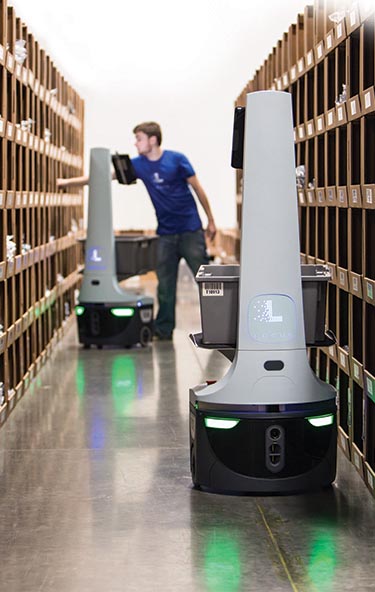 One of the first pilots to turn into an implementation is in a medical device fulfillment center in Memphis. In January 2018, DHL began deploying 56 mobile robots (Locus Robotics) in the facility, which are planned to process some 8,000 orders per day.
One of the first pilots to turn into an implementation is in a medical device fulfillment center in Memphis. In January 2018, DHL began deploying 56 mobile robots (Locus Robotics) in the facility, which are planned to process some 8,000 orders per day.
In this application, DHL is using what Adrian Kumar, vice president of solutions design, describes as a swarming approach: Instead of assigning a robot to a picker, associates remain in their area of a pick zone; the robots, meanwhile, are free agents that are directed by the warehouse management system (WMS). Multiple robots can “swarm” into a pick zone.
“We started with six robots in an 18,000-square-foot area with 31 aisles,” says Kumar. “We then went to 12 robots, 24 and now 56. The picking zone went to 99,000 square feet.” Kumar adds that based on experimenting with various zone pick strategies, with this profile DHL has found a ratio of four robots to one picker to be the most efficient.
Kumar says two factors helped them decide to implement the robots following the pilot. One was that DHL’s customer made a major acquisition that significantly increased the volume of orders going through that facility.
Meanwhile, with its proximity to Federal Express’ hub and serious competition for warehouse labor, DHL wanted to get more productive with its existing workforce rather than add hard-to-find labor. “During the pilot, we saw a two times productivity increase using the robots,” Kumar says. The big gain comes from the elimination of non-value-added travel by keeping associates in the pick zone.
The process begins when orders are received near the end of the day by hospitals served by the facility. The WMS passes orders to the robot’s software system. That system prioritizes orders based on their delivery date, since some orders may require delivery before 9 a.m. the next morning while others may not be required for two days. It then determines the best way to pick them. For instance, some orders may be too large to fit in a robot tote, which can have up to eight orders. Those will be assigned to a traditional pick-to-cart process. The remainder will be doled out to robots.
To get that process started, associates scan totes onto a robot at a prep station. The system then assigns an order or group of orders to that robot. At that point, the robot, or robots, begin to make their way through the pick zone, stopping at the nearest pick slot. There, a picker will see the item needed to be picked on a screen. Once that item is scanned into the tote, using a scanner on the robot, and the picker confirms the pick, the robot goes to the next slot until all items have been picked.
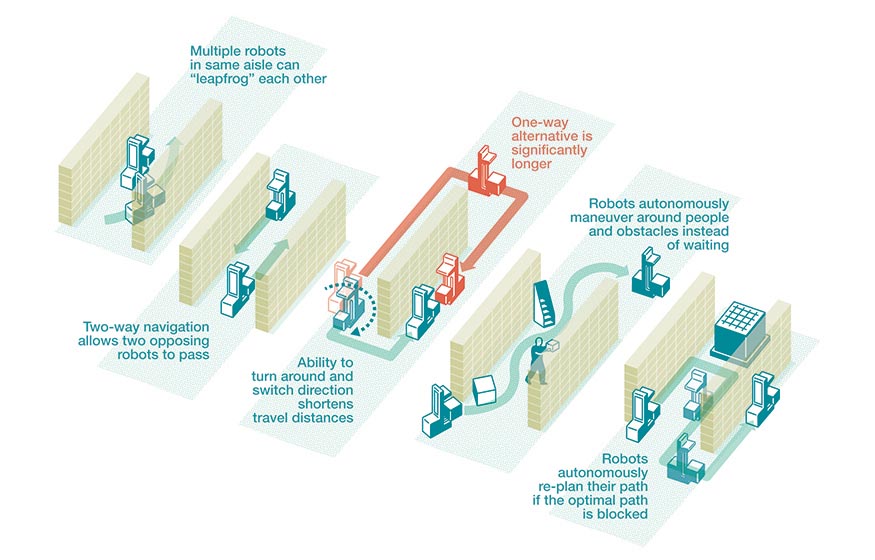
Once picking is complete, the robot automatically goes to a packing station, where the packer removes the full tote and inducts a new one. The packer then packs out the orders for delivery.
While a two times improvement in productivity is impressive, DHL is discovering ways to optimize the system. “If you just put pickers in a zone, there is going to be idle time when there are no picks for their area,” says Kumar. Rather than limiting a picker to a specific work area, the pickers are free agents who can roam, like the robots. Instead of just displaying the item to be picked on the screen, the system now displays subsequent picks for robots in close proximity. Pickers use this information to navigate their travel until the picks are completed. At that point, the picker can return to the original start point and wait for the next robot in the zone. “It’s a game-changer for us,” says Kumar. “We think we can get a 2.5 times increase in productivity, even as we’re adding aisles and volume since the pilot ended in July 2017.”












